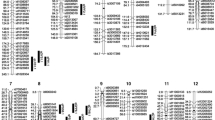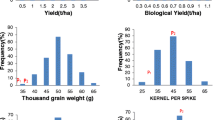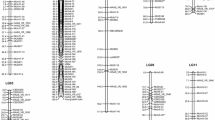Abstract
An F4:5 population of 490 recombinant inbred lines (RILs) from the cross Apo/2*Swarna was used to detect quantitative trait loci (QTL) with large effects on grain yield under drought stress using bulk-segregant analysis (BSA). Swarna is an important rainfed lowland rice variety grown on millions of hectares in Asia, but is highly susceptible to drought and aerobic soil conditions. Apo is an aerobic-adapted variety with moderate tolerance to drought. Two rice microsatellite (RM) markers, RM324, and RM416, located on chromosomes 2 and 3, respectively, were shown via BSA to be strongly associated with yield under lowland drought stress. The effects of these QTL were tested in a total of eight hydrological environments over a period of 3 years. The QTL linked to RM416 (DTY 3.1) had a large effect on grain yield under severe lowland drought stress, explaining about 31% of genetic variance for the trait (P < 0.0001). It also explained considerable variance for yield under mild stress in lowland conditions and aerobic environments. To our knowledge this is the first reported QTL that has a large effect on yield in both lowland drought and aerobic environments. The QTL linked to RM324 (DTY 2.1) had a highly significant effect on grain yield in lowland drought stress (R 2 = 13–16%) and in two aerobic trials. The effect of these QTL on grain yield was verified to be not mainly due to phenology differences. Effects of DTY 3.1 on yield under stress have been observed in several other rice mapping populations studied at IRRI. Results of this study indicate that BSA is an effective method of identifying QTL alleles with large effects on rice yield under severe drought stress. The Apo alleles for these large-effect QTL for grain yield under drought and aerobic conditions may be immediately exploited in marker-assisted-breeding to improve the drought tolerance of Swarna.


Similar content being viewed by others
References
Babu RC, Nguyen BD, Chamarerk V, Shanmugasundaram P, Chezhian P, Jeyaprakash P, Ganesh SK, Palchamy A, Sadasivam S, Sarkarung S, Wade LJ, Nguyen HT (2003) Genetic analysis of drought resistance in rice by molecular markers: association between secondary traits and field performance. Crop Sci 43:1457–1469
Bernier J, Kumar A, Venuprasad R, Spaner D, Atlin GN (2007) A large-effect QTL for grain yield under reproductive-stage drought stress in upland rice. Crop Sci 47:507–516
Bernier J, Atlin GN, Serraj R, Kumar A, Spaner D (2008) Breeding upland rice for drought resistance. J Sci Food Agric 88:927–939
Courtois B, Mclaren G, Sinha PK, Prasad K, Yadav R, Shen L (2000) Mapping QTLs associated with drought avoidance in upland rice. Mol Breed 6:55–66
George T, Magbanua R, Garrity DP, Tubana BS, Quinton J (2002) Rapid yield loss of rice cropped successively in aerobic soil. Agron J 94:981–989
Hemamalini GS, Shashidar HE, Hittalmani S (2000) Molecular marker-assisted tagging of morphological and physiological traits under two contrasting moisture regimes at peak vegetative stage in rice. Euphytica 112:69–78
Huke RE, Huke EH (1997) Rice area by type of culture: south, southeast, and east Asia. IRRI, Los Baños, Philippines
IRGSP (2005) The map-based sequence of the rice genome. Nature 436:793–800
Kamoshita A, Zhang J, Siopongco J, Sarkarung S, Nguyen HT, Wade LJ (2002) Effects of phenotyping environment on identification of quantitative trait loci for rice root morphology under anaerobic conditions. Crop Sci 42:255–265
Kim HJ, Hyun Y, Park JY, Park MJ, Park MK, Kim MD, Kim HJ, Lee MH, Moon J, Lee I, Kim J (2004) A genetic link between cold responses and flowering time through FVE in Arabidopsis thaliana. Nat Genet 36:167–171
Kumar R, Venuprasad R, Atlin GN (2007) Genetic analysis of rainfed lowland rice drought tolerance under naturally-occurring stress in eastern India: heritability and QTL effects. Field Crops Res 103:42–52
Kumar A, Bernier J, Verulkar S, Lafitte HR, Atlin GN (2008) Breeding for drought tolerance: direct selection for yield, response to selection and use of drought-tolerant donors in upland and lowland-adapted populations. Field Crops Res 107:221–231
Lanceras JC, Pantuwan G, Jongdee B, Toojinda T (2004) Quantitative trait loci associated with drought tolerance at reproductive stage in rice. Plant Physiol 135:384–399
Lander E, Botstein D (1989) Mapping Mendelian factors underlying quantitative traits using RFLP linkage maps. Genetics 121:185–199
Maccaferri M, Sanguineti MC, Corneti S, Ortega JLA, Salem MB, Bort J, DeAmbrogio E, del Moral LFG, Demontis A, El-Ahmed A, Maalouf F, Machlab H, Martos V, Moragues M, Motawaj J, Nachit M, Nserallah N, Ouabbou H, Royo C, Slama A, Tuberosa R (2008) Quantitative trait loci for grain yield and adaptation of durum wheat (Triticum durum Desf.) across a wide range of water availability. Genetics 178:489–511
Mackill DJ (2003) What molecular tools are available for selection for drought tolerance? In: Fischer KS, Lafitte R, Fukai S, Atlin GN, Hardy B (eds) Breeding rice for drought-prone environments. IRRI, Los Baños, Philippines, pp 55–57
Masle J, Gilmore SR, Farquhar D (2005) The ERECTA gene regulates plant transpiration in Arabidopsis. Nature 436:866–870
Michelmoore RW, Paran I, Kesseli RV (1991) Identification of markers linked to disease resistance genes by bulked segregant analysis: a rapid method to detect markers in specific genomic regions by using segregating populations. Proc Natl Acad Sci USA 88:9828–9832
Navabi A, Mather DE, Bernier J, Spaner DM, Atlin GN (2009) QTL detection with bidirectional and unidirectional selective genotyping: marker-based and trait-based analyses. Theor Appl Genet 118:347–358
Ouk M, Basnayake J, Tsubo M, Fukai S, Fischer KS, Cooper M, Nesbitt H (2006) Use of drought response index for identification of drought tolerant genotypes in rainfed lowland rice. Field Crops Res 99:48–58
Pandey S, Bhandari HN, Hardy B (2007) Economic costs of drought and rice farmers’ coping mechanisms. IRRI, Los Baños, Philippines
Pantuwan G, Fukai S, Cooper M, Rajatasereekul S, O’Toole JC (2002) Yield response of rice (Oryza sativa L.) genotypes to drought under rainfed lowlands: 2. Selection of drought resistant genotypes. Field Crops Res 73:169–180
Price AH, Courtois B (1999) Mapping QTLs associated with drought resistance in rice: progress, problems and prospects. Plant Growth Regul 29:123–133
Price AH, Cairns JE, Horton P, Jones RGW, Griffiths H (2002) Linking drought-resistance mechanisms to drought avoidance in upland rice during a QTL approach: progress and new opportunities to integrate stomatal and mesophyll responses. J Exp Bot 53:989–1004
Quarrie S, Lazic-jancic V, Kovacevic D, Steed A, Pekic S (1999) Bulk segregant analysis with molecular markers and its use for improving drought resistance in maize. J Exp Bot 50:1299–1306
Sambrook J, Fritsch EF, Maniatis T (1989) Molecular cloning: a laboratory manual, 2nd edn. Cold Spring Harbour, New York
SAS Institute Inc (2004) SAS OnlineDoc® 9.1.3. SAS Institute Inc, Cary, NC, USA
Shashidhar HE, Vinod MS, Sudhir Naveen, Sharma GV, Krishnamurthy K (2005) Markers linked to grain yield using bulked segregant analysis approach in rice (Oryza sativa L.). Rice Genet Newsl 22:69–71
Shen X, Zhou M, Lu W, Ohm H (2003) Detection of Fusarium head blight resistance QTL in a wheat population using bulked segregant analysis. Theor Appl Genet 106:1041–1047
Temnykh S, Declerck G, Lukashova A, Lipovich L, Cartinhour S, McCouch S (2001) Computational and experimental analysis of microsatellites in rice (Oryza sativa L.): frequency, length variation, transposon associations, and genetic marker potential. Genome Res 11:1441–1452
Tripathy JN, Zhang J, Robin S, Nguyen TT, Nguyen HT (2000) QTLs for cell-membrane stability mapped in rice (Oryza sativa L.) under drought stress. Theor Appl Genet 100:1197–1202
Venuprasad R, Lafitte HR, Atlin GN (2007) Response to direct selection for grain yield under drought stress in rice. Crop Sci 47:285–293
Venuprasad R, Sta Cruz MT, Amante M, Magbanua R, Kumar A, Atlin GN (2008) Response to two cycles of divergent selection for grain yield under drought stress in four rice breeding populations. Field Crops Res 107:232–244
Venuprasad R, Bool ME, Dalid CO, Bernier J, Kumar A, Atlin GN (2009) Genetic loci responding to two cycles of divergent selection for grain yield under drought stress in a rice breeding population. Euphytica 167:261–269
Yadav R, Courtois B, Huang N, Mclaren G (1997) Mapping genes controlling root morphology and root distribution in a double-haploid population of rice. Theor Appl Genet 94:619–632
Yang J, Zhu J, Williams RW (2007) Mapping the genetic architecture of complex traits in experimental populations. Bioinformatics 23:527–1536
Yang J, Hu CC, Hu H, Yu R, Xia Z, Ye X, Zhu J (2008) QTLNetwork: mapping and visualizing genetic architecture of complex traits in experimental populations. Bioinformatics 24:721–723
Yano M, Kojima S, Takahashi Y, Lin H, Sasaki T (2001) Genetic control of flowering time in rice, a short-day plant. Plant Physiol 127:1425–1429
Yue B, Xue W, Xiong L, Yu X, Luo L, Cui K, Jin D, Xing Y, Zhang Q (2006) Genetic basis of drought resistance at reproductive stage in rice: separation of drought tolerance from drought avoidance. Genetics 172:1213–1228
Zhang J, Zheng HG, Aarti A, Pantuwan G, Nguyen TT, Tripathy JN, Sarial AK, Robin S, Babu RC, Nguyen BD, Sarkarung S, Blum A, Nguyen HT (2001) Locating genomic regions associated with components of drought resistance in rice: comparative mapping within and across species. Theor Appl Genet 103:19–29
Zheng HG, Babu RC, Pathan MS, Ali L, Huang N, Courtois B, Nguyen HT (2000) Quantitative trait loci for root penetration ability and root thickness in rice: comparison of genetic backgrounds. Genome 43:53–61
Zou GH, Liu HY, Mei HW, Liu GL, Yu XQ, Li MS, Wu JH, Chen L, Luo LJ (2008) Screening for drought resistance of rice recombinant inbred populations in the field. J Integr Plant Biol 49:1508–1516
Acknowledgments
This work was supported partly by funds from the Rockefeller Foundation, the Generation Challenge Program and the Bill & Melinda Gates Foundation. We thank Roger Magbanua for the help provided to conduct the field experiments.
Author information
Authors and Affiliations
Corresponding author
Additional information
Communicated by Q. Zhang.
Electronic supplementary material
This material is unfortunately not in the Publisher's archive anymore:
Supplementary Fig. 1: Weekly average rainfall, evaporation, ground water depth, and soil water potential (tensiometer reading at 20 cm depth) at the lowland drought experimental site during flowering period: IRRI DS 2008. (TIFF 63 kb)
Supplementary Fig. 2: Gel photos of markers selected based on bulk-segregant analysis. Marker name and lane names are indicated at the top the respective gel photo. Tails composited on basis of grain yield in DS 2006 lowland stress trial. RM324 and RM416 are located on chromosomes 2 (66 cM) and 3 (191.6 cM) respectively (Source: Temnykh et al. 2001). (TIFF 117 kb)
Rights and permissions
About this article
Cite this article
Venuprasad, R., Dalid, C.O., Del Valle, M. et al. Identification and characterization of large-effect quantitative trait loci for grain yield under lowland drought stress in rice using bulk-segregant analysis. Theor Appl Genet 120, 177–190 (2009). https://doi.org/10.1007/s00122-009-1168-1
Received:
Accepted:
Published:
Issue Date:
DOI: https://doi.org/10.1007/s00122-009-1168-1




